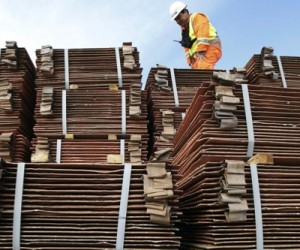The real reason the copper price is being crushed

Kenneth Hoffman Bloomberg Intelligence: At the end of the day price is the final arbiter
Given its widespread use in manufacturing and construction coupled with the fact that China consumes 45% of the world’s supply, copper has been bearing the brunt of this bearishness.
On Wednesday in New York trade December copper contracts were trending weaker again after breaching the key $5,000 level yesterday for the first time since the global financial crisis.
Bloomberg Intelligence analyst Kenneth Hoffman spoke to MINING.com after returning from a tour of China to find out the true state of copper demand in the country.
Hoffman has been visiting China for the past twenty years and in 2015 saw a sea-change in sentiment inside the world’s second largest economy:
“A few years back the analysts and companies in London started to get more and more concerned. Then it sort of spread to Canada and slowly moved to Singapore and Hong Kong.
“China up until late last year was pretty optimistic.
“When I went in April there was a decided change in the mood. On this last trip I was really surprised how negative sentiment has become. I was often asked: “What is a bullish thing you could say?” Everyone was just so bearish and concerned about what was going to happen.”

Pile ’em high
Hoffman says it could be a very painful transitions and may take longer than expected: “I asked many analysts and traders in China how long can the downturn last? And it ranged from three years to ten years.”
While worries about the slumping economy has been around for longer, the drop in equities which has wiped trillions of the market value of stocks has come as a real shock to Chinese sentiment.
In its report Bloomberg Intelligence says the mood of Chinese metal traders is closely linked to the performance of equity markets. Expectations are that the government would be able to stabilize stock markets over the short term (although this week’s fresh falls put that in doubt) and that copper has been oversold. However, “slowing growth is leaving them bearish on long term demand.”
Bloomberg Intelligence expects Chinese copper demand to fall by 2% to 4% in 2015 with the main drivers sharply declining construction markets which account for an estimated 30% to 40% of copper use, flat to lower auto production at 10% to 15% of demand and slow growth in infrastructure spending.
Most investment banks and research analysts are still forecasting a positive growth rate (although those have also been steadily lowered this year), but Hoffman says with all the big drivers down a contraction “shouldn’t be a big surprise to anybody.”
With regard to the supply side what concerns Hoffman is that “you’ve had a lot of price-positive supply side events in copper. Power in Zambia, strikes, high arsenic levels in Chile, bad weather. Yet you have the copper price down by 20%.”
And with 1.5 million new tonnes hitting the market this year and the same supply growth in 2016 according to Bloomberg, the good news on supply constraint may be over.
Elevated inventory levels also have something to do with the price slide.
LME inventories have risen over the past year to above 350,000 tonnes (but are down more than 40% since its 2013 peak), Shanghai Futures Exchange stocks after a big drop has now climbed back above the 100,000 tonne mark and bonded warehouse stocks inside China hold some 650,000 tonnes according to Bloomberg data.
But that’s not enough to explain the depth of today’s bear market following a 17% slide in 2014 and 19.5% slump so far this year.
China’s unreported copper inventories are key to understanding global metals markets says Hoffman, but the extent of these undisclosed inventories of copper – tied up in financing deals or held in various forms of ore, cathode or semi-finished products – are impossible to measure.
Inventories that go unreported to the government are stored in warehouses holding hundreds or thousands of tonnes that are scattered across the country. And it could hold a magnitude of the stocks visible to the market.
Hofmann says people would literally stack copper in their garages and hold as little as 50 tonnes or 100 tonnes: “There’s just no way to know what that number is. It’s an impossible number. When it comes back into the market you know it’s there.”
One reason commodity backed financing deals – usually carried out in China’s vast shadow banking system – are so popular is because it is highly lucrative.
Or was. Until the People’s Bank dropped a currency bomb last week.
“The devaluation of the yuan is really going to crush the carry trade,” says Hoffman.
“The carry trade goes like this: I take my metal, go to the bank, borrow dollars or yuan outside the country using the bank as a throughput and the metal as a backstop and invest it inside China for a much higher interest.
“You’re borrowing at 1% and you’re investing locally at 12% or 13% pretty much guaranteed. That’s a great deal”.
The Bank of International Settlements (the central bank of central banks) estimates the amounts tied up in the carry trade in China at $850 billion. Hoffman believes the use of metals like copper, nickel and gold as part of the carry trade and other financing deals may be greatly underestimated.
Hoffman says he’s aware of a copper facility that grew inventories from 50,000 to 200,000 tonnes: “The owner told me the only reason I did that is because I make so much money off the carry trade I don’t even care about making the pipes.”
“We’ll only find out how much metal was tied up in those deals when it hits the marketplace. But in a declining price environment it can quickly become a death spiral.”
As the commodities fall in value, banks may demand additional collateral or the sale of the metals to satisfy the loan. Borrowers then may choose to walk away, leaving lenders to decide if and when to liquidate the collateral inventory.
The unwinding of the carry trade making visible this inventory will have other far-reaching implications.
It would force a recalibration of the assumptions of mining companies and a rethink of what the underlying Chinese metal demand really has been all along says Hoffman.
And the answer to how much metal was simply being channeled into shadow banking may not be something anyone wants to hear now that overall Chinese growth is slowing.
{{ commodity.name }}
{{ post.title }}
{{ post.date }}




8 Comments
Peter Kay
A good read.
ziggy
charts say there is further to fall in the copper price. First to fall uranium, then rare earths, then iron ore, then oil, then coal, then tungsten, then gold, nickel and copper simultaneously. my guess to which one is next…graphite????
Jonas_Barbarossa
Yep, a good read indeed and one that made me wonder…
Since 2008 not one of the criminals who caused the collapse has been charged and hence we stumble from the one major fraud to the next. It is understandable that governments are powerless because money and the state cannot be separated. However, the state needs to understand that it cannot operate on the same principles: greed!; as is the case in ever-complaining Africa and in a similar sense elsewhere. The lobby (read corruptors) knows what I’m talking about.
Secondly, what does that bode for us as a civilization? Are these massive economies looking only after themselves or do they look after humanity? The world is a village and my neighbor’s actions affect me.
Thirdly, the wars! It is no wonder that there is a global feeling that traditional leadership and democracy does not work; hence ISIL and other ideological wars.
Ultimately we have to agree that we need leadership in these times. As the US heads to the polls we all need to reflect on these issues and this article does a great job of getting us thinking.
Franklinguven
Article rightly points out it is difficult to know what is really going on. Meanwhile in the last hour Platts reports: China’s copper consumption to grow by 5.7% in 2015, reaching 9.22 million mt, says Beijing Antaike report
Gene Byrge
The real problem is that the world is awash in currencies of all types, of course the dollar on top. But the folks controlling this vast volume of currency are faced every day with finding a home for MORE, MORE, MORE. So they all watch the boards and each other minutely, and move together like lemmings or sardines.This causes false rise and fall effect, too rapidly and too strongly, so in the end the money gets eaten by the market forces which are basically out of control. SOLUTION: Change the whole system to reality based versus Fiat based. CHANCES of that happening NIL. Meanwhile RIDE THE GOLDEN BULL. WHATEVER YOU DO DON’T HOLD CURRENCY.
Pat Wood
Bloomberg Intelligence is an oxymoron.
Copper collateralized for loans, is material that won’t enter the production stream until the loans are repaid.
The Chinese economy is growing, and with it, so is copper consumption. Perhaps not as fast as last year.
China imports about 84% of their implied demand, annually. While Chile is the largest producer of copper (on a country basis), China is No. 2.
Last year, Chinese copper miners produced about 1.9mm metric tonnes copper.
The industry is highly fragmented, and about 50% of the domestic industry is unprofitable at $2.30/lb. copper. Simply put, this supply will vanish if copper prices stay low for too much longer.
Taking out that supply from the world market would lead to copper shortages, in an industry that continually fails to live up to output expectations, annually.
Bloomberg Intelligence is stupid, as is the article.
Pat Wood
Bloomberg Intelligence fails (utterly fails) to mention the record levels of speculative short futures positions that presently exist on futures exchanges. Wonder why?
It’s a fact. Copper shorts have open interest at record levels.
Instead, undocumented phantom supply is discussed.
Show me the copper, Bloomberg.
Otherwise, go peddle Goldman Sach’s research elsewhere.
Gene Byrge
How fine to see people involved in bettering the world. YOU CAN make a difference.
As one who cares for all of you, I would suggest you Google up The Acton Institute, and read through the ruminations located there. So much thought to reflect upon. Much truism.
AS a parting shot on the markets, the law of supply and demand is natural and correct. Men, whether politicians or financial mavens,would alter the natural order of events to fit their plots and plans. This, in turn is not beneficial to mankind in its’ natural order. Perversion of the natural order damages the smooth flow of universal harmony. We are all, then obliged to weed out the unnatural and maintain the universal order. We, the society of the world, MUST remove the weeds from the fields of life.